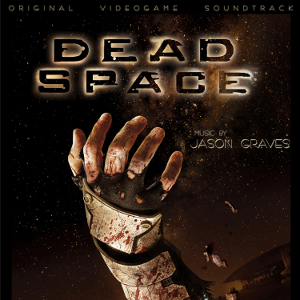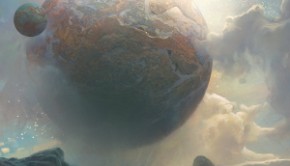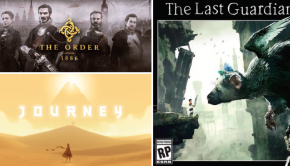Dead Space Original Videogame Soundtrack
 |
Album Title: Dead Space Original Videogame Soundtrack |
| Record Label: Electronic Arts |
|
| Catalog No.: N/A |
|
| Release Date: November 11, 2008 |
|
| Purchase: Download at iTunes |
Overview
It’s not like the “lonely human on a space ship fights creepy monsters” concept hadn’t been done dozens of times in video games before Dead Space came along in 2008. But the game’s ability to instil gamers with a true sense of terror and fright netted Dead Space to strong reviews and propelled it to sales of close to two million. And of course, sequels and prequels emerged quickly enough.
One of the game’s most outstanding features was Jason Grave’s stylistically distinctive soundtrack. Graves was already a game score veteran when he started to work on Dead Space, but it was this soundtrack that catapulted him into the spotlight. His score, both as a standalone element and as part of the game’s sound design, garnered several awards, among them two G.A.N.G. Awards and two BAFTAs. Reviews hailed the work as an important step forward for video game soundtracks in general and Graves called it “the most challenging and rewarding score I’ve ever worked on.” For the digital album release of Dead Space, the three hours of material Graves had composed were compressed distilled into a one hour stand-alone product.
Body
So what was it that brought Dead Space so much attention and set it apart from other video game scores? Well, the reason will literally jump at you when you listen to the album’s second track “Welcome Aboard The U.S.G. Ishimura”, enjoying the eerie atmosphere the music emanates — and then an unholy racket of orchestral noise grabs your throat and refuses to let you go. Certainly, the extensive use of dissonance was nothing new to Western video games — Michael Giacchino’s Call of Duty and Gary Schyman’s BioShock had deployed non-melodic sounds frequently — but none of them to the degree that Dead Space does. Impressively ferocious, the action music on the title heavily draws upon the avant-garde stylings of 20th century composers such as Gyorgy Ligeti and Krzystof Penderecki. A first listen to a track like “The Necromorphs Attack” is quite an experience and one that’s probably unlike any other in the realm of video game scores.
There is hardly anything the listener can latch onto — the music is devoid of melody, harmony, tonality or chord progression. Instead, the orchestra goes berserk, with the various sections of the orchestra going into several different directions at the same time. Several layers of percussion, often playing syncopated and/or independent rhythms, bombard the listener with a barrage of sound that’s complemented by enormous brass clusters and strings that frantically whir away in the background, whine during dissonant glissandi or add chaotic, aleatoric pizzicati. During other passages, the string players are required to tap with their fingers on their instrument’s body. Indeed, if you happen to enjoy unusual instrumental techniques, Dead Space is a veritable treasure trove.
The only point of orientation during this immense musical frenzy is the often thunderous percussion. But its forceful sounds turn out to be an unreliable guide due to the constantly shifting rhythmic patterns, metres and tempi. Similar to Elliot Goldenthal’s score for Alien 3, Dead Space‘s score explores the boundaries of what’s traditionally considered “music”. Instead, in its frequent rejection of recognisable features like melodies, the score rather functions as a provider of sound effects. And that’s indeed the plan, as Dead Space‘s audio designer Don Veca described in an interview. Music and sound effects were to merge into one unit and thus the game’s score would have to be textural rather melodic. Accordingly, Graves actually first recorded with the orchestra all kinds of scary noises and textures before piecing together compositions out of this “toolbox” of sounds.
The result of all this is a claustrophobic wall of sound that’s gob-smacking and perfectly communicates the sensation of fleeing in sheer terror from something monstrous, without a chance to catch a breath and reflect on what’s happening around you. At this stage, Graves’ music is superbly atmospheric and occasionally breathtaking. Its use of rarely deployed avant-garde scoring and performing techniques pays off in spades and creates music that in its unfamiliarity is disorienting and consequently terrifying. This is another successfully realised facet of the elaborate sound design behind Dead Space: “What sounds scary? Things you don’t recognize. How do you make music unrecognizable to the player? Use contemporary orchestral techniques and make the music as NON-musical as possible”, as Grave so convincingly explained in an interview.
Obviously, such an approach is based on the assumption that the listener is largely unfamiliar with such non-traditional sounds. But even a seasoned veteran of avant-garde classical music would be in for a surprise or two on Dead Space. As mentioned above, there’s a number of composers that clearly inspired Graves, and one could add Jerry Goldsmith’s work on Alien and Christopher Young to that list. But Graves puts his own mark on Dead Space. More so than any of the works that Dead Space stylistically references, this score is exceptionally relentless in its use of dissonances and its insistence on fortissimo levels. In other words: long stretches of the album are not just bitingly harsh, but will also rattle your walls when the volume’s turned up to an appropriate level. A good part of this effect is due to the percussion-heavy nature of most action cues, which also gives the title an identity of its own. Such consistently propulsive and at the same time dissonant cues are something new in the worlds of game and film soundtracks. In its convergence of styles, Dead Space fuses the non-melodic tendencies of its 20th classical music inspirations with the action-packed sounds of a first person shooter score.
There are only very few occasions when melodic moments take centre stage on Dead Space, but Graves knows that such injections of consonance are necessary to provide some respite from the orchestral onslaught. These moments of conventional harmonic beauty are usually provided by what is the only melodic construct that serves as a theme in the traditional sense. That theme is written for the protagonist’s girlfriend Nicole, who’s the reason why our hero is on that infested spaceship — he desperately tries to safe her. Signifying the protagonist’s main motivation to risk his life on the U.S.G. Ishimura, Nicole’s theme then regularly turns up on Dead Space. It is first presented on “Welcome” and proves captivating in it’s foreboding sense of tragedy. A heavy-going, melancholic deep string melody that remains unresolved, this theme lets the listener know quickly that this tale will likely not end well. Also popping up on “Manual Survival Mode Seven” and “The Cost Of Living Is On The Rise” and providing much-needed moments of calm, the theme reaches its emotional apex on “Farewell To Nicole”. Here, it is submitted to number of moving variations, all performed by the string orchestra. It bears mentioning that this is one of the few instances during which Dead Space becomes emotionally engaging.
It’s worthwhile to step back for a second and consider Dead Space‘s success and the amount of attention it brought Graves from both soundtrack outlets and mainstream media in terms of how much its particular style contributed to this attention. The title can be viewed as an important entry into that never-ending discussion about if video games — and thus video game scores — are “art”. And sure enough, Dead Space makes a good case for video games. After all, what says “art” (with a capital A) louder than something as challenging as 20th century classical music? This is not to suggest that the success the game’s music has enjoyed is simply due to the style it was written in. But considering that Graves has described his contribution to the franchise as “a little high-brow” and “the antithesis of videogame music”, it’s certainly valid to regard Graves’ score as a work that self-consciously plays with exceptions of how video game soundtracks sound — and which has attracted considerable attention because of this manoeuvre.
Stylistic inventiveness notwithstanding, Dead Space is not without its problems and they mainly stem from two sources: the way the music has travelled from game onto album, and the quality of the score’s quieter interludes. Part of the game’s audio design is a sophisticated engine that would play back the music as four layered streams and mix the four musical layers based on the state protagonist was in at any given time: the more dangerous the situation, the more frantic the music, for example. Translating such a dynamic and immersive music design into a linear, stand album presentation is a considerable challenge. And unfortunately, this process doesn’t always go right. According to Veca, one of the purposes of Dead Space‘s audio design was to lead up “to the big “BOO!” moment”. On the album, that lead up hardly occurs because the wild, threatening orchestral frenzy is so dominant — it’s not a “BOO!” moment that’s created, rather a constant “BOO!” state. There are only few moments of surprise, only some occasions when the soundtrack keeps the listener on the edge, fearful of the next time the monsters will appear again, simply because the music is noisy not only during climaxes, but for so much of the album’s running time. And like in a film where monsters keep jumping out of dark corners, it all get’s somewhat tiring and loses its intended effect — it’s scary the first few times, but after a while, it’s just something the consumer expects to happen.
Part of this problem is the paradoxical fact that while the musically unknown can be a perfect tool to scare listeners, the unknown stops being unknown after a while if it’s repeated too often without variation. Graves’ exercises in dissonance initially reap amazing results, particularly on more vicious tracks like “The Necromorphs Attack” and “The Leviathan”, which are mesmerising in their sheer power. But what’s terrifying on track two becomes merely spectacular routine by the time track fourteen, “The Cost Of Living Is On The Rise” comes around. Too much of the music is pitched at the same unrelenting intensity and deploys the same massive textures. Somewhat frustratingly, there are moments when Dead Space does demonstrate how more variety can be added to the horror-inducing formula. The beginning of “The Hive Mind” has the orchestra holding back for a while, so that the focus is on the disembodied, chilling cries of the woodwinds, which otherwise are buried under the layers of orchestral noise. “Fly Me To The Aegis Seven Moon” applies some structure to the musical chaos and slowly escalates over an insisting string rhythm into violent anarchy, instead of simply starting as such. But there are not enough such instances to avoid monotony towards the end of the album.
The other issue is that, while there actually is a decent chunk of quieter material on the album that’s supposed to balance the more raucous moments, that material isn’t always particularly interesting. This is particularly true for those compositions that require more restrained passages to not turn into a constant noise fest: the action tracks. Many of them do actually feature quieter intros or middle sections. But more often than not, on tracks like “Do Not Vomit – Do Not Shout”, “Cyanide Systems Offline” and “The Cost Of Living Is On The Rise”, the more atmospheric material is too anonymous to hold the listener’s attention and simply passes by without making an impact before the rowdy orchestra strikes again. This has the effect that listeners will likely register mostly the action parts of the soundtrack, which contributes to the feeling of monotony described previously.
When the atmospheric material is more engaging though, it injects the music with a deeply involving sense of drama. Graves would develop this interplay of contrasts further on Dead Space 2, which capitalises on the tension between piano and forte moments more successfully. On Dead Space, “Welcome Aboard The U.S.G. Ishimura” is the prime example on how to get this mixture right. The piece’s disconsolate introduction of Nicole’s theme and its quiet static, richly orchestrated textures communicate the widerness of space and the isolation of the infected ship perfectly and constantly keep up the tension, without hinting too obviously at the horror to follow. And that makes the moment the discordant orchestral hits attack for the first time all the more disturbing. Increasing this cue’s effectiveness, the album’s preceding, first track “Dead Space Theme” has set the scene appropriately with its eerie tones and a chromatic two-note string figure that effectively destabilises the harmonic structure of the composition. Again, it’s the subtle hint at dread that’s as important as the actual occurrence of that dread — a realisation that Dead Space 2 would take to heart more than Dead Space.
Summary
Dead Space‘s soundtrack raised a ruckus upon its release, and for good reason. Jason Graves unleashes an orchestral storm that is without precedent, at least within the world of game music scores. Its uncompromising use of aggressive dissonances and its refusal to work within the conventional parameters of melody, harmony and constant rhythm put Dead Space into a category of its own — one that’s heavily influenced by 20th century avant-garde classical music. Needless to say, it’s a challenging listen. But many moments on this album are so visceral that one can’t help admiring Graves’ compositional skills and his will to go all the way and summon up such amazingly intense music.
What holds the album back is the fact that there’s too much of a good thing. For too long, the music is pitched at the same intensity and what is breathtaking at the beginning of the album becomes slightly tiresome by the end of it when presented in mostly the same way as before. Graves doubtlessly has discovered a spectacular formula on Dead Space, but it would him take until Dead Space 2 to refine it and apply it with more consistently successful results. Still, Dead Space remains a recommended listen for everybody looking for a game soundtrack that treads new ground — there’s nothing quite like it out there.
Do you agree with the review and score? Let us know in the comments below!
3.5
Posted on January 25, 2011 by Simon Elchlepp. Last modified on June 4, 2014.














